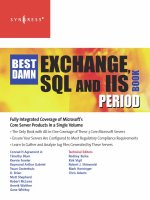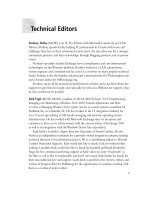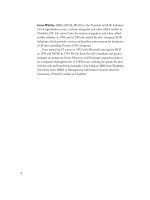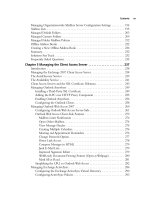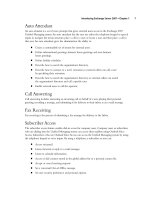Exxhange SQL And IIS- P43 ppsx
Bạn đang xem bản rút gọn của tài liệu. Xem và tải ngay bản đầy đủ của tài liệu tại đây (187.41 KB, 5 trang )
Managing the Exchange 2007 Mailbox Server Role • Chapter 4 187
As is also the case with the user permissions, you can confi gure administrative permissions using
the Exchange 2003 System Manager. You do so by following these steps:
1. On the respective Exchange 2003 Server, open the System Manager by clicking
Start | All Programs | Microsoft Exchange | Exchange System Manager.
2. Drill down to the Folders and expand the Public Folders node.
3. Now right-click the Public Folder for which you want to add or remove administrative
permissions, then select Properties.
4. Click the Permissions tab.
5. Click the Administrative Rights button. Here you can see each user that has already
been granted permissions to administer the Public Folder.
6. Click Add and add the respective user(s) to the administrative permission list (see Figure 4.23),
then click OK.
Figure 4.23 Administrative Rights on a Public Folder
188 Chapter 4 • Managing the Exchange 2007 Mailbox Server Role
7. Now select the user(s) you just added, then grant the type of administrative permission
you want the user to have. You do so by ticking the respective permission boxes under
Permissions for Administrator.
8. Finally, click OK and exit the Exchange 2003 System Manager.
Managing Public Folder Replica Settings
Another feature missing in the Exchange 2007 Management Console is the option of confi guring
Public Folder replication settings. This also has to be done using either the EMS or an Exchange 2003
server that’s still part of your Exchange organization.
To stop or resume Public Folder replication, you can use the Stop-PublicFolderReplication and
Resume-PublicFolderReplication CMDlets, respectively.
To add Public Folder databases to or remove them from a replica list, you’ll need to use the
an Exchange 2003 System Manager.
Mail-Enabling a Public Folder
You might run into situations where you want to mail-enable a Public Folder—perhaps you’ll want
your users to be able to send messages to the folder in addition to posting messages. Because
Public Folders by default are not mail-enabled, you need to mail-enable them using either the
Enable-MailPublicFolder CMDlet or an Exchange 2003 System Manager. To mail-enable the Finance
Public Folder we created earlier using the Enable-MailPublicFolder CMDlet, we would need to type:
Enable-MailPublicFolder -Identity “\Finance” followed by Enter
If you don’t want the Public Folder to appear in the GAL, you would need to include the
HiddenFromAddressListsEnabled parameter, and the command would look like the following:
Enable-MailPublicFolder -Identity “\Finance” -HiddenFromAddressListsEnabled
followed by pressing Enter.
NOTE
You need to create a Public Folder before you can mail-enable it.
To get a list of the mail-enabled Public Folders in your organization, you can use the
Get-MailPublicFolder CMDlet. To get information for a specifi c mail-enabled Public Folder,
type Get-MailPublicFolder –Identity <public_folder>.
Managing the Exchange 2007 Mailbox Server Role • Chapter 4 189
If you don’t specify an SMTP address when you mail-enable a Public Folder, it will use the name
of the Public Folder. So, if the Public Folder is called Finance and the domain is Exchangedogfood.dk,
the address will be fi If you want to use another primary SMTP address,
you need to set it using the Set-MailPublicFolder CMDlet. The command would then be:
Set-MailPublicFolder -Identity “\Finance” -PrimarySmtpAddress:
followed by pressing Enter.
Many other Set-MailPublicFolder CMDlet parameters are available. We won’t go into details on
each of them, but instead we list each of them with a short description in Table 4.4.
Table 4.4 Parameters Available for a Mail-Enabled Public Folder
Parameter Description
AcceptMessagesOnlyFrom Accept messages only if sent by the specifi ed recipients.
AcceptMessagesOnlyFrom- Accepts messages sent to the DL only if sent by
DLMembers DL members.
Alias Used to specify the alias (mail nickname) of the Public
Folder. If not specifi ed, it is stamped as the Public Folder
Name. The string must comply with RFC 2821
requirements for valid “local part” SMTP addresses.
Contacts Specifi es the contacts for the Public Folder.
CustomAttribute (1–15) Used to specify a custom attribute.
DeliverToMailboxAndForward Specifi es whether or not e-mail will be sent to
a forwarding address.
DisplayName Specifi es the display name of the Public Folder
Proxy Object.
DomainController Specifi es which DC to connect to.
EmailAddresses Proxy addresses. Example:
EmailAddressPolicyEnabled Used to have a recipient policy applied to the
Public Folder.
ForwardingAddress Delivery options: Sets the forwarding address for
the folder.
GrantSendOnBehalfTo Distinguished name of other mailboxes that can send
on behalf of this folder.
HiddenFromAddressLists- Specifi es whether or not the mailbox is viewable from
Enabled address lists.
Instance This is an actual ADObject instance that is piped to
and consumed by the task.
Continued
190 Chapter 4 • Managing the Exchange 2007 Mailbox Server Role
To mail-enable a Public Folder using an Exchange 2003 System Manager, perform the
following steps:
1. On the respective Exchange 2003 Server open the System Manager by clicking
Start | All Programs | Microsoft Exchange | Exchange System Manager.
2. Drill down to the Folders and expand the Public Folders node.
3. Now right-click the Public Folder you want to mail-enable, then select Properties.
4. Select the E-mail Addresses tab (see Figure 4.24).
Table 4.4 Continued
Parameter Description
MaxReceiveSize This parameter specifi es the maximum size of e-mail
messages that can be received, from 1KB to 2,097,151KB.
If not specifi ed, there is no limit.
MaxSendSize This parameter specifi es the maximum size of e-mail
messages that can be sent, from 1KB to 2,097,151KB.
If not specifi ed, there is no limit.
Name Used to specify the name of the Public Folder.
PrimarySmtpAddress Used to specify the primary SMTP address to be used
by the Public Folder.
PublicFolderType Used to specify the type of Public Folder.
RejectMessagesFrom Used to specify SMTP addresses that should not be
allowed to send messages to the Public Folder.
RejectMessagesFrom- Used to specify distribution lists that should not be
DLMembers allowed to send to this Public Folder.
RequireSenderAuthentication- Specifi es whether or not senders must be authenticated.
Enabled
SimpleDisplayName Used to specify a simple (a.k.a. friendly) display name.
WindowsEmailAddress An e-mail address in the format
NOTE
If you want to remove the mail attributes from a mail-enabled public folder, use the
Disable-MailPublicFolder CMDlet.
Managing the Exchange 2007 Mailbox Server Role • Chapter 4 191
5. Click the New button, then click SMTP Address.
6. Type the SMTP address you want to assign to the Public Folder, then click OK twice and
exit the Exchange 2003 System Manager.
Figure 4.24 The E-mail Addresses Tab on the Properties Page for a Public Folder
NOTE
Features such as delivery restriction, Send on behalf etc. can of course also be
confi gured via the Exchange 2003 System Manager, you do so under the
Exchange General tab.
